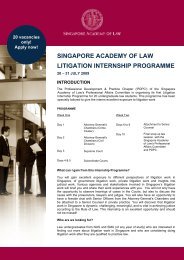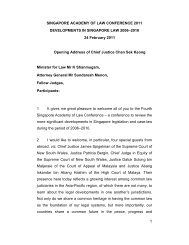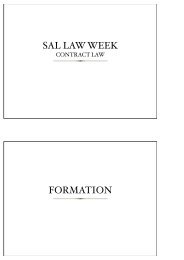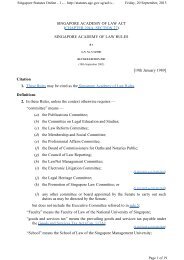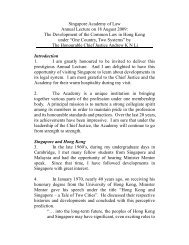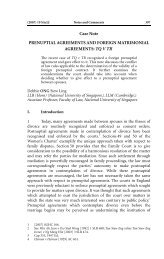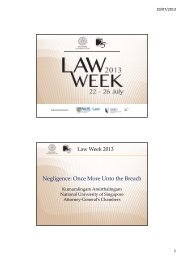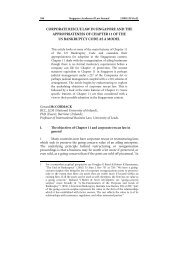2. Managing Mens Rea in Singapore - Singapore Academy of Law
2. Managing Mens Rea in Singapore - Singapore Academy of Law
2. Managing Mens Rea in Singapore - Singapore Academy of Law
Create successful ePaper yourself
Turn your PDF publications into a flip-book with our unique Google optimized e-Paper software.
346S<strong>in</strong>gapore <strong>Academy</strong> <strong>of</strong> <strong>Law</strong> Journal (2006)did not actually know but ought to have known, that is sufficient. Theproblem is not new and has never been satisfactorily resolved. In oneother similar situation, 98the court applied the negligence standardwithout address<strong>in</strong>g the problem <strong>of</strong> <strong>in</strong>consistency with words <strong>in</strong>dicat<strong>in</strong>g ahigher degree <strong>of</strong> mens rea. One might have thought that the pr<strong>in</strong>ciple that<strong>in</strong>terpretational ambiguities ought to be settled <strong>in</strong> favour <strong>of</strong> the accusedwould have applied. The draft<strong>in</strong>g solution is simple – either adopt one orthe other, not both. One is tempted to speculate that the failure to identifyand fix such a long-stand<strong>in</strong>g problem stems from a certa<strong>in</strong> legislativeawkwardness when it comes to the handl<strong>in</strong>g <strong>of</strong> negligence as a crim<strong>in</strong>alconcept. Second, there is a massive bunch<strong>in</strong>g together <strong>of</strong> vastly differentdegrees <strong>of</strong> mens rea – from <strong>in</strong>tention (which presumably means that themotive <strong>of</strong> the accused is to aid terrorist activity), to knowledge, tonegligence. Problems <strong>of</strong> fair labell<strong>in</strong>g arise – it would be ak<strong>in</strong> to creat<strong>in</strong>gone large <strong>of</strong>fence <strong>of</strong> homicide from <strong>in</strong>tentional to negligent kill<strong>in</strong>g.Problems <strong>of</strong> proportionate punishment portend. Aga<strong>in</strong>, this is not new,and has emerged <strong>in</strong> the context <strong>of</strong> the famous s 304A <strong>of</strong> the Penal Code:Whoever causes the death <strong>of</strong> any person by do<strong>in</strong>g any rash or negligentact not amount<strong>in</strong>g to culpable homicide, shall be punished withimprisonment for a term which may extend to 2 years, or with f<strong>in</strong>e, orwith both. [emphasis added]61 It is now established that the difference between rashness andnegligence is advertence – one is rash when one is actually aware <strong>of</strong> therisk <strong>of</strong> death, one is merely negligent when one is not so aware, but oughtto have been. 99 Advertent risk <strong>of</strong> death is <strong>of</strong> course far more blameworthy98 A similar piece <strong>of</strong> sloppy draft<strong>in</strong>g is found <strong>in</strong> s 411, Penal Code, which def<strong>in</strong>ed the<strong>of</strong>fence <strong>of</strong> dishonest receipt <strong>of</strong> stolen property:Whoever dishonestly receives or reta<strong>in</strong>s any stolen property, know<strong>in</strong>g or hav<strong>in</strong>greason to believe the same to be stolen property, shall be punished … [emphasisadded]This formulation is clearly nonsensical – dishonesty under the Penal Code requires,by s 24, knowledge <strong>of</strong> wrongful ga<strong>in</strong> or loss. One who does not know but only hasreason to believe that the property concerned was stolen can never be dishonest.Faced with this, the court <strong>in</strong> Ow Yew Beng v PP [2003] 1 SLR 536 at [11] said:Section 411, read with s 24, clearly envisages that an <strong>in</strong>dividual can bedishonest, ie hav<strong>in</strong>g an <strong>in</strong>tention to cause wrongful ga<strong>in</strong> or loss, even though hehas no actual knowledge, but only reason to believe that the property was stolen… Logically, dishonesty under s 411 would have to bear the broader mean<strong>in</strong>g <strong>of</strong>an <strong>in</strong>tention to cause ga<strong>in</strong> or loss which the accused either knows or has reason tobelieve was wrongful. [emphasis <strong>in</strong> orig<strong>in</strong>al]There is certa<strong>in</strong>ly no logical way out – either s 24 or s 411 is wrong. It is just asimpermissible to add words to s 24, as it is to ignore the phrase “or hav<strong>in</strong>g reason tobelieve” <strong>in</strong> s 411.99 PP v Teo Poh Leng [1992] 1 SLR 15.



